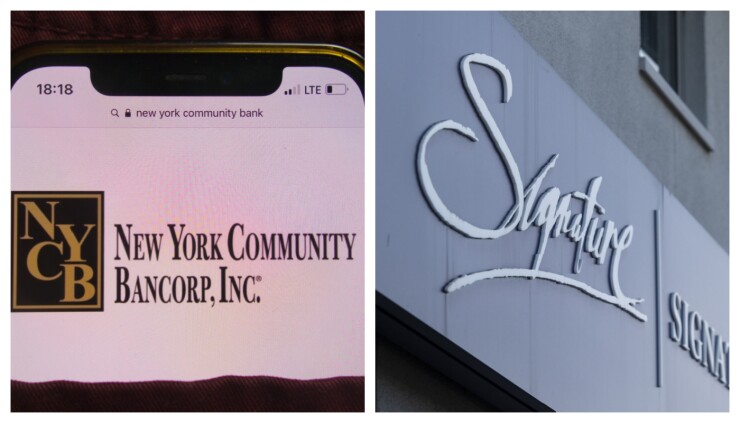
For most of the past decade, New York Community Bancorp sat firmly in the category of smaller U.S. regional banks.
Its assets hovered in the $50 billion range, it operated 200-plus retail branches in five states and it built a niche business by making loans to landlords who own rent-stabilized apartment buildings, primarily in New York City.
But back-to-back deals to buy Flagstar Bancorp and large chunks of the failed Signature Bank thrust the Long Island-based company into a new sphere. In the span of six months, New York Community's assets nearly doubled, with Signature pushing it above $100 billion, the threshold where banks start to face more regulatory requirements and higher expenses.
Now, nearly 12 months after a banking crisis wiped out Signature and two other regional banks,
And while there are important differences between
Today, like many other banks that grew quickly, New York Community finds itself the subject of heightened regulatory scrutiny.
"Fast growth is always a red flag, for regulators and risk," said Chip MacDonald, a longtime financial services attorney and managing director of MacDonald Partners in Atlanta. "Fast growth means the bank is doing something different from what has been its normal course of business."
New York Community's rapid growth in recent quarters reflected its efforts under President and CEO Thomas Cangemi to become a full-fledged commercial bank, rather than a thrift. As of Sept. 30, 2022, two months before it acquired Troy, Michigan-based Flagstar, the bank reported $63 billion of assets. That figure rose 43% after the deal closed, when assets totaled $90.1 billion.
Then in late March 2023, New York Community emerged as the winning bidder for large portions of Signature Bank, and its total assets rose yet again to $123.7 billion — an increase of more than 37% from the prior quarter.
All of the growth brought unintended consequences. Two weeks ago, the company surprised investors by
During the company's fourth-quarter earnings call, Cangemi told analysts that the Signature acquisition pushed the bank over the $100 billion-asset threshold "sooner than … anticipated."
As a result, the bank is now subject to "enhanced prudential standards" such as risk-based and leverage capital requirements, liquidity standards and new stress-testing requirements, he said.
"Going from $90 billion prior to the acquisition of Signature … and catapulted into the $100 billion club, we have some balance sheet items that we need to focus on," Cangemi said.
The market's reaction was swift. New York Community's stock price fell 37% on the day the company announced its quarterly results. Over the next several days, questions mounted about the quality of its commercial real estate loan portfolio and the stability of its deposits. Its share price continued to tumble, and some of the bank's credit ratings were downgraded by the likes of Moody's Investor Services, Fitch Ratings and Morningstar DRBS.
Amid the turmoil, New York Community shuffled its management team,
"We will build a financial plan that gradually builds capital — no ifs, ands or buts," DiNello said. "If we must shrink, then we'll shrink. If we must sell non-strategic assets, then we'll do that."
The rapid growth exposed New York Community to new potential risks, industry observers say.
Its expansion also brought about a change in regulatory oversight. During its long wait to acquire Flagstar, New York Community
"I think after Signature, the OCC went into New York Community looking for potential problems, particularly problems caused by fast growth," said MacDonald, who does not represent the Hicksville, New York-based bank. "It was the first time they were there, and that size brings more supervision."
Silicon Valley Bank, Signature Bank and First Republic Bank, all of which failed last year, had also been growing faster than their peers.
At SVB Financial Group, the California-based parent company of the failed Silicon Valley Bank, average total assets more than quadrupled over a five-year period ending in the third quarter of 2022, when they totaled $216.1 billion. The increase in size stemmed largely from a boom period in startup and venture capital funding, which helped SVB
At New York City-based Signature, assets jumped 43% between the first quarter of 2021 and the same quarter the following year, reflecting
At First Republic in San Francisco, assets rose about 50% between the first quarter of 2021 and the first quarter of 2023, in part because of
Historically, fast-growing banks haven't fared particularly well in terms of longevity, noted Arthur Wilmarth Jr., a professor emeritus at George Washington University Law School.
"A large number of the worst failures involved institutions that had grown very rapidly, usually through a combination of mergers-and-acquisitions and organic growth," Wilmarth said.
But in an industry facing consolidation, some banks may see expansion as a way to survive. The larger the bank, the greater the chance of picking up "too big to fail" status, Wilmarth said.
Fast growth is not an inherent death knell for banks, analysts say. Western Alliance Bancorp. has been
Cullen/Frost Bankers in San Antonio is finding success by
Considering New York Community's challenges, one might question whether it should have acquired Signature. But some analysts argued that the deal made sense as a way to accelerate the bank's strategic shift.
"When Tom got promoted to CEO, the mandate was to bring in core deposits and diversify the loan portfolio, and the Signature deal did both of those things," said Peter Winter, an analyst at D.A. Davidson. "It took years off that transformation, so it was the right deal."
"It was just the circumstance of crossing $100 billion," he added.
In light of the three regional bank failures last spring and New York Community's current challenges, there's "permanent damage" to the "investor psyche around growth banks," said Casey Haire, an analyst at Jefferies.
"This is not an industry that should grow 10% or 20%," Haire said. "It should be glacial. And if someone is growing faster than the herd, the regulators are going to start asking questions."






